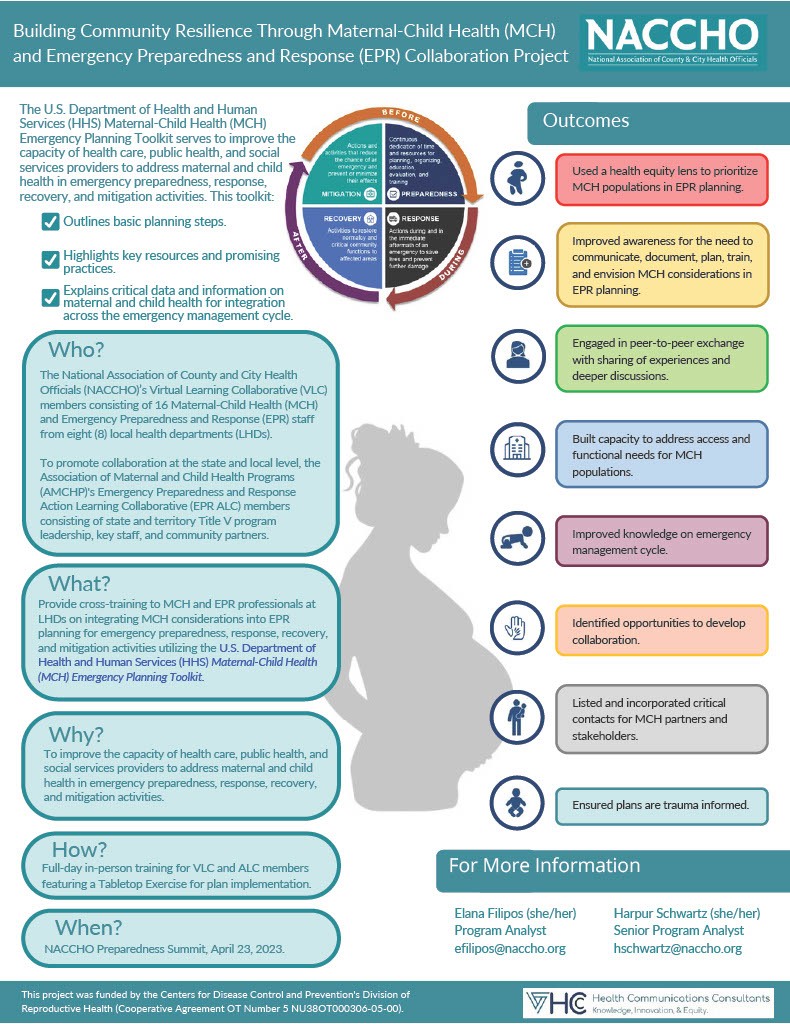Co-Authored by Mikayla Frye and Benjamin Kaufman, Association of Maternal & Child Health Programs (AMCHP)
Local health departments (LHDs) play critical roles in responding to the many public health crises across the country. Though these crises can and do profoundly impact pregnant people and infants, maternal and child health (MCH) and emergency preparedness and response (EPR) departments within LHDs are often siloed. MCH considerations are rarely integrated into emergency planning processes. The COVID-19 pandemic, extreme weather events, and other public health emergencies have demonstrated a need to support and prioritize MCH populations in the development of EPR training, exercises, and plans.
NACCHO’s Virtual Learning Collaborative
To meet the needs of MCH populations during public health emergencies, NACCHO, with funding from the CDC’s Division of Reproductive Health, launched a Virtual Learning Collaborative (VLC) to increase collaboration among MCH and EPR colleagues within LHDs. The VLC is guided by the U.S. Department of Health and Human Services (HHS) Maternal-Child Health (MCH) Emergency Planning Toolkit and consists of training exercises and case study discussions to strengthen the capacity of LHDs to prioritize MCH populations in emergency preparedness, response, recovery, and mitigation activities. In 2022, NACCHO launched its second cohort of the VLC, convening eight LHDs comprised of one MCH staff member and one EPR staff member from each institution -- Florida Department of Health in Citrus County (FL); Houston Health Department (TX); Louisville Metro Department of Public Health & Wellness (KY); Mohave County Department of Public Health (AZ); Riley County Health Department (KS); St. Lawrence County Public Health Department (NY); Talbot County Health Department (MD); Zanesville-Muskingum County Health Department (OH).

Tabletop Exercise at NACCHO’s 2023 Preparedness Summit
This year, NACCHO led the 2022-2023 VLC members through an in-person tabletop exercise (TTX) at NACCHO’s 2023 Preparedness Summit, in partnership with Health Communications Consultants, Inc. (HCC), who served as facilitators. To promote collaboration at the state and local levels, NACCHO invited the Association of Maternal and Child Health Programs (AMCHP)’s Emergency Preparedness and Response Action Learning Collaborative (EPR ALC) members to attend. The EPR ALC comprises state and territory Title V program leadership, key staff, and community partners.
Participants spent the day in small groups walking through a severe weather hazard and infant formula shortage emergency scenario to assess plans, policies, and procedures – all aimed at improving the capacity of their health departments to address MCH considerations in emergencies. Participants also had the opportunity to review and update their organizations’ operational plans to ensure they are equipped to address the access and functional needs of MCH populations throughout preparedness, response, recovery, and mitigation activities. The TTX was designed to help participants identify key resources, community partners, and other stakeholders that should be incorporated throughout the emergency management cycle to ensure MCH populations are prioritized during all-hazards events.
“Discuss and Decide” Prompts and Tabletop Activities
The TTX was initiated by introducing the emergency scenario, followed by a “Discuss and Decide” prompt in small groups. This allowed time for each small group to discuss how their organization would proceed in response to the scenario based on their MCH population demographics. Each group answered the following questions:
- What are your next steps based on these considerations, as well as your current plans and capabilities?
- What MCH partner organizations need to be involved?
- What are your proposed timelines, communication protocols, additional resources, and considerations for MCH populations?
After working through the “Discuss and Decide” prompts, everyone came back together for a full group discussion and report out. This was followed by a few minutes of individual and team reflection to answer the following questions:
- In what ways does your existing Emergency Preparedness Plan(s) account for the current scenario?
- What is missing/are there gaps?
- What needs to be addressed, improved, and updated?
- Who else needs to be at the table?
Updates regarding the emergency scenario were introduced throughout the day, followed by the same “Discuss and Decide” prompts and group discussion for each update. Participants were given a workbook with space to write notes about resources, action steps, etc. to bring back to their jurisdictions.
Using Resource Injects as Discussion Prompts
Unique to this TTX, NACCHO staff sent out resource injects that were directly relevant to each of the scenario updates. For those looking to incorporate MCH considerations into emergency planning better, some of the guides, toolkits, and checklists are listed below:
- Preparing for Disaster for People with Disabilities and Other Special Needs
- Human Trafficking in the Wake of a Disaster (CDC)
- Urgent Maternal Warning Signs Educational Materials
- Conversation Guide and Palm Card for Pregnant or Recently Pregnant Women (CDC Hear Her Campaign)
- Ensuring Language Access and Effective Communication During Response and Recovery: A Checklist for Emergency Responders (HHS)
- Shelter from the Storm: Tips for Shelter Professionals
Tabletop Successes and Next Steps
85% of TTX participants reported that the training provided them with opportunities to implement agency action plans that specifically addressed the needs of MCH populations. Participants also indicated that participating in the TTX helped them identify key resources - including partner organizations - at the local, state, and national levels that could support their efforts to prioritize MCH populations in emergency planning, response, and recovery. One participant shared, “I really enjoyed the tabletop-- it was great to meet everyone in person! I think everyone had the chance to share their best practices, and it felt like a great way to learn. I’m looking forward to bringing this information back to my LHD and start reviewing our PHEP plans.” NACCHO and AMCHP encouraged all participants to take similar action within their respective spheres of influence.
NACCHO hopes to continue offering these types of opportunities, including in partnership with our AMCHP colleagues, to strengthen future collaboration between MCH and EPR. Staff are currently working to develop a suite of materials, resources, and tools to support other LHDs looking to begin this process. If you have questions, ideas, or experiences you think we can learn from, please feel free to contact Elana Filipos ([email protected]) and Harpur Schwartz ([email protected]).
This project was funded by the Centers for Disease Control and Prevention’s Division of Reproductive Health (Cooperative Agreement OT Number 5 NU38OT000306-05-00).



